ミラクル☆トレイン 『Insights 2012 世界を読むメディア英語入門2012』掲載レビュー
概要
大学用の時事英語教科書『Insights 2012 世界を読むメディア英語入門2012』で、ミラクル☆トレインが紹介されました。
(レビューした日:2012.03.01)
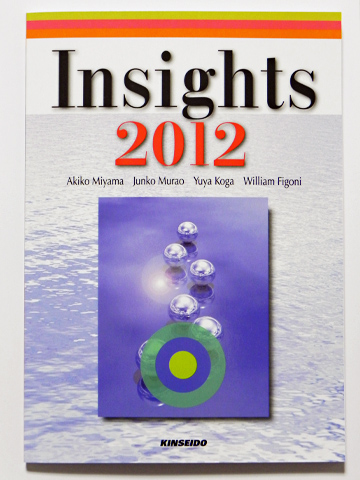
『Insights 2012 世界を読むメディア英語入門2012』
編著者:深山晶子/村尾純子/古賀友也/William Figoni
発行所:株式会社 金星堂
発行日:2012年1月20日 初版第1刷発行、2012年2月20日 初版第2刷発行
ISBN:978-4-7647-3934-5
テキスト内容
Chapter 14 『Stations Take Human Forms 「駅」擬人化プロジェクト!』
P.83
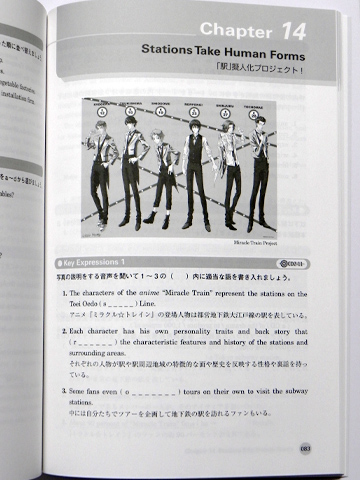
メインビジュアルと、イントロダクション。
P.84
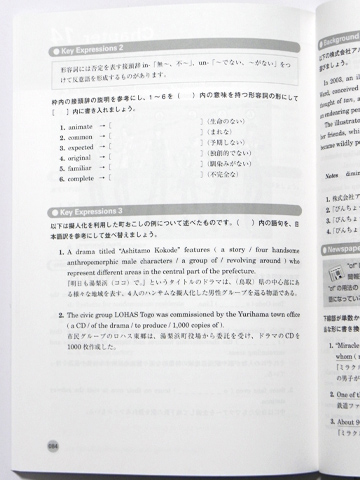
擬人化キャラクターを使って町おこしをした、鳥取県湯梨浜町の事例。
P.85
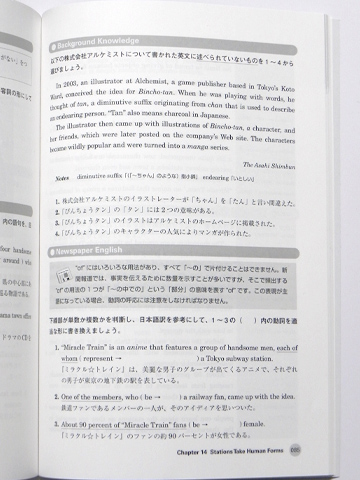
炭の擬人化キャラクターである「びんちょうタン」が誕生した経緯。
下半分はミラトレの話題。
P.86〜P.87
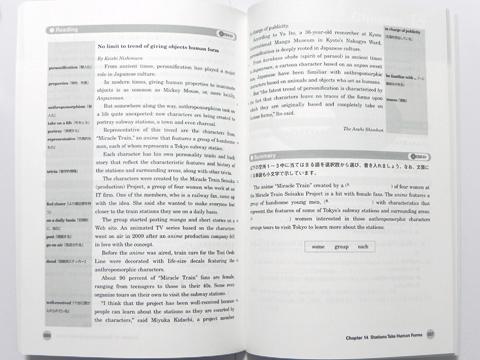
キャプターのメイン部分。朝日新聞の記事が使用されているようです。
以下に原文を引用し、私が訳した訳文を載せます。(Google翻訳を併用)
No limit to trend of giving object human form
By Keishi Nishimura
From ancient times, personification has played a major role in Japanese culture.
In modern times, giving human properties to inanimate objects is as common as Mickey Mouse, or, more locally, Anpanman.
But somewhere along the way, anthropomorphism took on a life quite unexpected: now characters are being created to portray subway stations, a town and even charcoal.
Representative of this trend are the characters from "Miracle Train", an anime that features a group of handsome men, each of whom represents a Tokyo subway station.
Each character has his own personality traits and back story that reflect the characteristic features and history of the stations and surrounding areas, along with other trivia.
The characters were created by the Miracle Train Seisaku (production) Project, a group of four women who work at an IT firm. One of members, who is a railway fan, came up with the idea. She said she wanted to make everyone feel closer to the train stations they use on a daily basis.
The group started posting manga and short stories on a Web site. An animated TV series based on the characters went on air in 2009 after an anime production company fell in love with the concept.
Before the anime was aired, train cars for the Toei Oedo Line were decorated with life-size decals featuring the anthropomorphic characters.
About 90 percent of "Miracle Train" fans are female, ranging from teenagers to those in their 40s. Some even organize tours on their own to visit the subway stations.
"I think that the project has been well-received because people can learn about the stations as they are escorted by the characters", said Miyuka Kidachi, a project member in charge of publicity.
Acording to Yu Ito, a 36-year-old researcher at Kyoto International Manga Museum in Kyoto's Nakagyo Ward, personification is deeply rooted in Japanese culture.
From karakasa obake (spirit of parasol) in ancient times to Anpanman, a cartoon character based on an anpan sweet bun, Japanese have been familiar with anthropomorphic characters based on animals and objects who act as humans.
But "the latest trend of personification is characterized by the fact that characters leave no traces of the forms upon which they are originally based and completely take on human forms", Ito said.
The Asahi Shimbun
『とどまるところを知らない擬人化の波』 Keishi Nishimura
昔から、擬人化は日本文化に大きな役割を果たしてきました。 現代では、生命のない物に人間の性質を与えることは、ミッキーマウスや、もっとローカルなレベルではアンパンマンで分かるとおり、一般的なことです。 しかしその途中で、擬人化はかなり予想外の道を歩み始めました――現在は地下鉄の駅、町、炭でさえもキャラクターになっているのです。
このトレンドの代表は『ミラクル☆トレイン』、それぞれが東京の地下鉄の駅を表した、美形な男性のキャラクターたちが特徴のアニメです。 それぞれのキャラクターは、本人の性格やバックストーリーに、駅や周辺地域の特徴や歴史、トリビアが反映されています。
キャラクターは、ミラクル☆トレインプロジェクト――IT企業で働く4人の女性のグループによって作成されました。 鉄道ファンであるメンバーの一人がアイデアを思い付いたのです。 彼女は、日常的に使う電車の駅を、より身近に感じられるようにしたいと思いました。
プロジェクトは、マンガとショートストーリーをウェブサイト上に掲載しました。 コンセプトを気に入ったアニメ制作会社は、キャラクターを使用したTVアニメシリーズを2009年に放送しました。 アニメが放映される前には、都営大江戸線の車両が、擬人化キャラクターをあしらった等身大のステッカーで飾られました。
『ミラクル☆トレイン』ファンは、ティーンエイジャーから40代まで、約90%が女性です。 地下鉄の駅を訪問するために、自分でツアーを企画する人もいます。 プロジェクトの広報担当、木立己百花さんは「キャラクターにエスコートされながら駅について学べる点が、プロジェクトが広く受け入れられている理由だと思います」と語っています。
京都市中京区にある『京都国際マンガミュージアム』の研究員、伊藤遊さん(36歳)によれば、擬人化は深く日本文化に根ざしているといいます。 日本人は、昔の唐傘おばけ(唐傘の妖怪)からアンパンマン(あんぱんを元にしたマンガのキャラクター)にいたるまで、動物や物が人間のように振る舞う、擬人化されたキャラクターに慣れ親しんできました。 伊藤さんによると、「最近の擬人化は、彼らの元となったものの痕跡を残さず、完全に人の姿になるという傾向にある」そうです。
(朝日新聞)
P.88
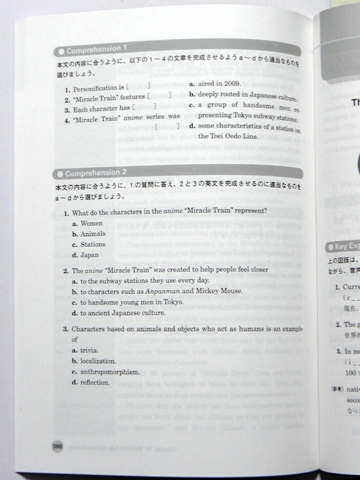
本文の内容を踏まえての選択問題。
雑感とか
日本文化やプロジェクトの成り立ちなど、かなり踏み込んだ内容になっています。
ただ、あくまでも「作品」としての紹介で、個々のキャラクターについては触れられていないのがちょっと残念です。
P.83に載っているメインビジュアルで駅名は確認できるので、よしとしましょうか。
ちなみにあの絵柄は、原作版ポスターに使われているものです。 >> ポスターが貼り出されている例
ファンの約90%が女性というのは、イベントなどでは体感していますが、実際にデータがあったんですね……。
そして「自分でツアーを企画する人」……ええ、まさにここにいますね。
駅メンに会いに行くのは楽しいですよ!
それにしても、インターナショナルになったというか、なんというか……。
この教科書で実際に勉強した大学生の感想も聞いてみたいところです。